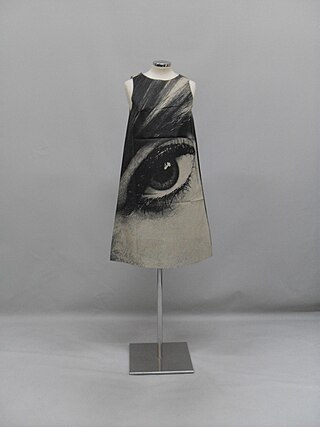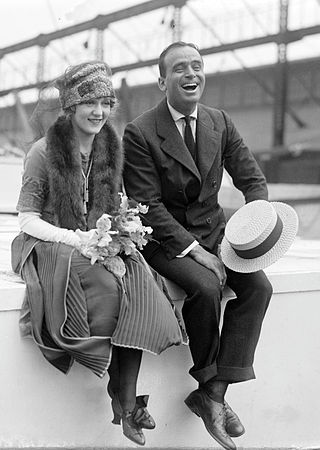
A miniskirt is a skirt with its hemline well above the knees, generally at mid-thigh level, normally no longer than 10 cm (4 in) below the buttocks; and a dress with such a hemline is called a minidress or a miniskirt dress. A micro-miniskirt or microskirt is a miniskirt with its hemline at the upper thigh, at or just below crotch or underwear level.

Dame Barbara Mary Quant was a British fashion designer and icon. She became an instrumental figure in the 1960s London-based Mod and youth fashion movements, and played a prominent role in London's Swinging Sixties culture. She was one of the designers who took credit for the miniskirt and hotpants. Ernestine Carter wrote: "It is given to a fortunate few to be born at the right time, in the right place, with the right talents. In recent fashion there are three: Chanel, Dior, and Mary Quant."

A crinoline is a stiff or structured petticoat designed to hold out a skirt, popular at various times since the mid-19th century. Originally, crinoline described a stiff fabric made of horsehair ("crin") and cotton or linen which was used to make underskirts and as a dress lining. The term crin or crinoline continues to be applied to a nylon stiffening tape used for interfacing and lining hemlines in the 21st century.

A hobble skirt was a skirt with a narrow enough hem to significantly impede the wearer's stride. It was called a "hobble skirt" because it seemed to hobble any woman as she walked. Hobble skirts were a short-lived fashion trend that peaked between 1908 and 1914.

Alberta Ferretti is an Italian fashion designer and dressmaker. She designed for her namesake brand Alberta Ferretti from its foundation in 1981 to 2024, and designed for Philosophy di Alberta Ferretti until 2014. Her showroom is in Milan, Italy but her studio is in her native village of Cattolica, near Rimini, Italy.

Youthquake was a 1960s cultural movement. The term was coined by Vogue magazine's editor-in-chief Diana Vreeland in 1965. Youthquake involved music and pop culture, and it changed the landscape of the fashion industry. The movement is characterized by looking to youth culture for a source of inspiration, taking dominance away from the English and Parisian couture houses.

Fashion of the 1980s was characterized by a rejection of 1970s fashion. Punk fashion began as a reaction against both the hippie movement of the past decades and the materialist values of the current decade. The first half of the decade was relatively tame in comparison to the second half, which was when apparel became very bright and vivid in appearance.

Azzedine Alaïa was a Tunisian couturier and shoe designer, particularly successful beginning in the 1980s.

Fashion of the 1960s featured a number of diverse trends, as part of a decade that broke many fashion traditions, adopted new cultures, and launched a new age of social movements. Around the middle of the decade, fashions arising from small pockets of young people in a few urban centers received large amounts of media publicity, and began to heavily influence both the haute couture of elite designers and the mass-market manufacturers. Examples include the mini skirt, culottes, go-go boots, and more experimental fashions, less often seen on the street, such as curved PVC dresses and other PVC clothes.

Western fashion in the 1920s underwent a modernization. Women's fashion continued to evolve from the restrictions of gender roles and traditional styles of the Victorian era. Women wore looser clothing which revealed more of the arms and legs, that had begun at least a decade prior with the rising of hemlines to the ankle and the movement from the S-bend corset to the columnar silhouette of the 1910s. Men also began to wear less formal daily attire and athletic clothing or 'Sportswear' became a part of mainstream fashion for the first time.

Outside Western cultures, men's clothing commonly includes skirts and skirt-like garments; however, in the Americas and much of Europe, skirts are usually seen as feminine clothing and socially stigmatized for men and boys to wear, despite having done so for centuries. While there are exceptions, most notably the cassock and the kilt, these are not generally considered skirts in the typical sense of fashion wear; rather they are worn as cultural and vocational garments. People have variously attempted to promote the fashionable wearing of skirts by men in Western culture and to do away with this gender distinction.

Lanvin is a French luxury fashion house founded in 1889 by Jeanne Lanvin in Paris. It is the oldest French fashion house still in operation. Since 2018, it has been a subsidiary of Shanghai-based Lanvin Group.

Anne Fogarty was an American fashion designer, active 1940–1980, who was noted for her understated, ladylike designs that were accessible to American women on a limited income. She started out as a model in New York in 1939, working for Harvey Berin on Seventh Avenue, before studying fashion design. She eventually secured a full-time design job in 1948, and became well-known for full-skirted designs with fitted bodices, inspired by Dior's New Look.

Kendra Scott is an American fashion designer. She is the executive chairwoman, designer, and former chief executive officer of Kendra Scott, LLC. In 2017, she was named Ernst & Young's National Entrepreneur of the Year.

The clothing style and fashion sense of the Philippines in the modern-day era have been influenced by the indigenous peoples, Chinese waves of immigration, the Spaniards, and the Americans, as evidenced by the chronology of events that occurred in Philippine history. At present, Filipinos conform their way of dressing based on classic fashion or prevailing fashion trends.
Ruta Anna "Ruth" Tarvydas was an Australian fashion designer. She opened her first boutique at the age of 19, with her brother, and shortly after established her first label. In 1983, Taryvdas became the first Australian designer to export clothing overseas. By the 2000s, she had designs being sold in 170 outlets across 16 countries, with a number of celebrity clients, both in Australia and overseas. A flagship store in King Street, Perth, was opened in 2009, but closed three years later with Tarvydas in heavy debt. A new store was opened in Claremont in 2012, and was featured with Tarvydas in a 2013 ABC1 documentary. Tarvydas was to debut at Paris Fashion Week in 2014, but she died two months before the event.
Fashion activism is the practice of using fashion as a medium for social, political, and environmental change. The term has been used recurringly in the works of designers and scholars Lynda Grose, Kate Fletcher, Mathilda Tham, Kirsi Niinimäki, Anja-Lisa Hirscher, Zoe Romano, and Orsola de Castro, as they refer to systemic social and political change through the means of fashion. It is also a term used by some fashion designers, one being Stella McCartney. The spectacle of fashion activism as street protest has also been a theme in Paris Catwalk shows. The term is used by Céline Semaan, co-founder of the Slow Factory Foundation.
Jessica Metcalfe is a Native American art historian focused on Native American fashion, educator, author, and owner of Beyond Buckskin Boutique. She is a citizen of the Turtle Mountain Chippewa Tribe in Belcourt, North Dakota.
Fashion in Iran has a cultural and economic impact on the county of Iran. During the Pahlavi era around the mid-1930s, Western fashion was introduced to the country and greatly influenced women's style. After the Iranian Revolution in 1978–1979, the hijab has become compulsory, which impacted the creation of clothing style.

The fashion industry in Nigeria plays an important cultural role and contributes significantly to the country's economy. Clothing incorporates a variety of colours, fabrics, and embellishments. Many of the component cultures of Nigeria wear styles that are characteristic of their tribal society and customs. Nigeria produces fashionable textiles and finished garments and has designers who have achieved international recognition.
















